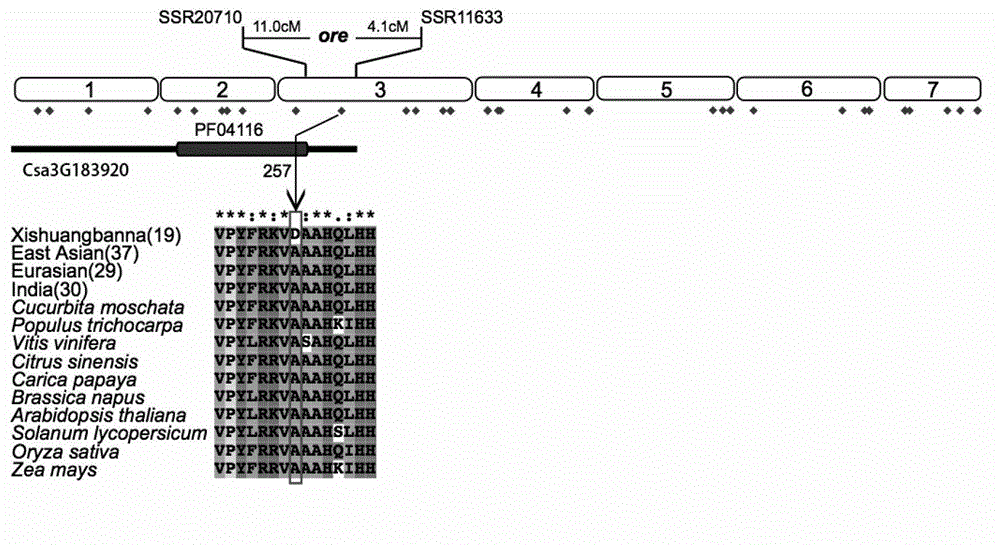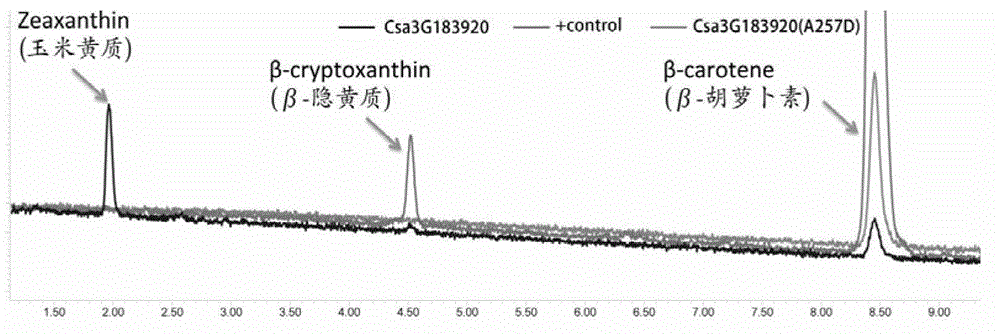Cucumber fruit beta carotene content related SNP marker and its application
A technology of β-carotene and cucumber, which is applied in the field of genetic engineering and molecular biology, can solve the problems of unclear molecular mechanism and slow progress of molecular breeding work, and achieve the effect of speeding up the breeding process, accurate and reliable results, and high genetic stability
- Summary
- Abstract
- Description
- Claims
- Application Information
AI Technical Summary
Problems solved by technology
Method used
Image
Examples
Embodiment 1
[0026] Example 1 Acquisition of SNP markers related to cucumber fruit β-carotene content and pulp color traits
[0027] More than 3,000 accessions of cucumber were collected from all over the world, and 114 accessions were selected as cucumber core germplasm resources, which represented 80% of the genetic diversity (Lv et al.). Each resource was resequenced to generate a data volume of about 5G, covering an average of 10x cucumber genome. According to the calculated Fst value, the cucumber resources in the world can be divided into 3 cultivated groups and 1 wild group ( figure 1 ). In order to adapt to the local natural environment and be affected by human factors, these three cultivated groups have undergone independent evolution. Among them, the content of β-carotene in the fruit of Xishuangbanna population is very high, and the color of the pulp is orange-red, which is not found in other populations. Therefore, using bioinformatics, set Fst=1, and further search for hete...
Embodiment 2
[0028] Example 2 Acquisition of Cucumber Csa3G183920 Gene
[0029] Using primers 5'-GCCTCTCCGCCGCCACTCTC-3' and 5'-TCAAGAACCATCTATTGATTTTCGAGCCGT-3', the mutant and wild-type Csa3G183920 genes were amplified from the cDNA of Xishuangbanna and East Asian cucumber fruit, respectively, and connected to the T vector (TAKARA). mutation.
[0030] The nucleotide sequence of the cucumber Csa3G183920 gene is shown in SEQ ID No.2, and the amino acid sequence of its encoded protein is shown in SEQ ID No.1.
Embodiment 3
[0031] Example 3 Verification of the function of the Csa3G183920 gene by biochemical experiments
[0032] Using primers 5'-CGGGATCCATGGCGGCCGGCCTCTCCGCCGCCACTC-3' and 5'-ACGCGTCGACTCAAGAACCATCTATTGATTTTCGAGCCGT-3', the wild-type and mutated Csa3G183920 genes were constructed into the prokaryotic expression vector pET32 (Novogen), and then sequenced and identified correctly and then transferred into engineered Escherichia coli (Schwartz et al.). This Escherichia coli can express β-carotene synthase, so that excessive β-carotene is produced in the bacteria, and the color of the bacteria is orange-yellow. The Csa3G183920 gene is induced to express in the bacteria, and the Csa3G183920 protein has the activity of β-carotene hydroxylase, which can degrade β-carotene and cause the color of the bacteria to become lighter. The chemical composition of the bacteria was further detected by HPLC, and it was found that zeaxanthin was produced, and it was determined that Csa3G183920 could d...
PUM
 Login to View More
Login to View More Abstract
Description
Claims
Application Information
 Login to View More
Login to View More - R&D
- Intellectual Property
- Life Sciences
- Materials
- Tech Scout
- Unparalleled Data Quality
- Higher Quality Content
- 60% Fewer Hallucinations
Browse by: Latest US Patents, China's latest patents, Technical Efficacy Thesaurus, Application Domain, Technology Topic, Popular Technical Reports.
© 2025 PatSnap. All rights reserved.Legal|Privacy policy|Modern Slavery Act Transparency Statement|Sitemap|About US| Contact US: help@patsnap.com



